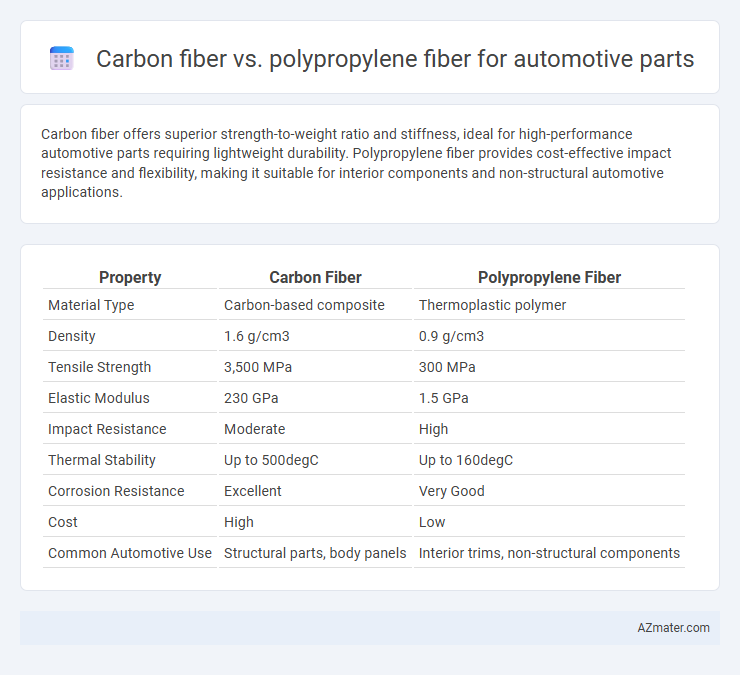Carbon fiber offers superior strength-to-weight ratio and stiffness, ideal for high-performance automotive parts requiring lightweight durability. Polypropylene fiber provides cost-effective impact resistance and flexibility, making it suitable for interior components and non-structural automotive applications.
Table of Comparison
| Property | Carbon Fiber | Polypropylene Fiber |
|---|---|---|
| Material Type | Carbon-based composite | Thermoplastic polymer |
| Density | 1.6 g/cm3 | 0.9 g/cm3 |
| Tensile Strength | 3,500 MPa | 300 MPa |
| Elastic Modulus | 230 GPa | 1.5 GPa |
| Impact Resistance | Moderate | High |
| Thermal Stability | Up to 500degC | Up to 160degC |
| Corrosion Resistance | Excellent | Very Good |
| Cost | High | Low |
| Common Automotive Use | Structural parts, body panels | Interior trims, non-structural components |
Introduction to Automotive Fiber Materials
Carbon fiber and polypropylene fiber are essential materials in automotive part manufacturing due to their distinct properties that enhance vehicle performance and efficiency. Carbon fiber offers exceptional strength-to-weight ratio and rigidity, making it ideal for structural components requiring high durability and lightweight characteristics. Polypropylene fiber provides excellent impact resistance, flexibility, and cost-effectiveness, commonly utilized in interior parts and trim elements to improve passenger safety and comfort.
Carbon Fiber Overview: Properties and Applications
Carbon fiber exhibits exceptional strength-to-weight ratio, superior stiffness, and outstanding fatigue resistance, making it ideal for high-performance automotive parts such as body panels, chassis components, and structural reinforcements. Its lightweight nature contributes to improved fuel efficiency and vehicle dynamics, while its resistance to corrosion and high temperatures ensures durability under demanding operating conditions. Carbon fiber composites are extensively utilized in sports cars, electric vehicles, and aerospace-inspired automotive designs to achieve optimal performance and safety standards.
Polypropylene Fiber Overview: Properties and Applications
Polypropylene fiber boasts lightweight, high chemical resistance, and excellent impact absorption, making it a versatile material in automotive parts such as interior trims, carpets, and sound insulation. Its low density and cost-effectiveness drive widespread use for reducing overall vehicle weight while maintaining durability and corrosion resistance. Polypropylene fiber's thermal stability and recyclability further support sustainable manufacturing practices in the automotive industry.
Mechanical Strength Comparison
Carbon fiber exhibits significantly higher tensile strength and stiffness compared to polypropylene fiber, making it ideal for automotive parts requiring superior mechanical performance and durability. Polypropylene fiber offers lower density and better impact resistance but cannot match the high modulus and fatigue resistance of carbon fiber. Automotive applications demanding lightweight structural components benefit from carbon fiber's exceptional strength-to-weight ratio, while polypropylene fiber suits less critical areas where flexibility and cost efficiency are prioritized.
Weight and Density Differences
Carbon fiber exhibits a significantly lower density of approximately 1.6 g/cm3 compared to polypropylene fiber's density around 0.9 g/cm3, but offers superior strength-to-weight ratio crucial for automotive applications. Despite polypropylene being lighter by absolute density, carbon fiber parts yield greater weight savings due to enhanced mechanical properties enabling thinner, lighter components. Automotive manufacturers prefer carbon fiber for weight reduction in high-performance parts, while polypropylene fiber is used where cost efficiency and moderate weight savings are prioritized.
Durability and Impact Resistance
Carbon fiber offers superior durability and exceptional impact resistance, making it ideal for high-performance automotive parts exposed to extreme stress and collisions. Polypropylene fiber provides good impact resistance with flexibility and lightweight characteristics but falls short in durability compared to carbon fiber under continuous mechanical loads. Selecting carbon fiber enhances the lifespan and safety of automotive components, while polypropylene remains cost-effective for less critical applications requiring moderate impact absorption.
Cost Analysis: Carbon vs Polypropylene Fibers
Carbon fiber offers superior strength-to-weight ratio but comes with significantly higher production costs, often exceeding $20 per pound, impacting overall vehicle manufacturing expenses. Polypropylene fiber, though less durable and strong, costs considerably less, typically around $1 to $2 per pound, making it a cost-effective choice for non-structural automotive components. Automakers balance performance requirements and budget constraints by selecting carbon fiber for high-performance parts, while polypropylene fiber serves economical applications with acceptable durability.
Manufacturing Processes and Feasibility
Carbon fiber composites require advanced manufacturing processes such as resin transfer molding (RTM) or automated fiber placement (AFP), offering superior strength-to-weight ratios ideal for high-performance automotive parts but with higher production costs and longer cycle times. Polypropylene fiber, commonly used in injection molding processes, enables faster, cost-effective mass production with moderate mechanical properties suitable for interior and low-stress applications. Feasibility for automotive parts depends on balancing performance needs and production volume, where carbon fiber excels in lightweight structural components, while polypropylene fiber is preferred for economical, large-scale manufacturing.
Sustainability and Environmental Impact
Carbon fiber offers high strength-to-weight ratio benefits but its production involves significant energy consumption and challenges in recycling, raising sustainability concerns in automotive applications. Polypropylene fiber is derived from petrochemicals but features lower energy use during manufacturing and better recyclability, contributing to reduced environmental impact in automotive parts. Selecting polypropylene fiber promotes a more circular economy by enabling easier material recovery and reuse compared to carbon fiber composites.
Conclusion: Best Fiber Choice for Automotive Parts
Carbon fiber outperforms polypropylene fiber in automotive parts due to its superior strength-to-weight ratio, stiffness, and thermal resistance, making it ideal for high-performance and structural components. Polypropylene fiber offers advantages in cost-effectiveness, impact resistance, and ease of processing, suited for non-structural interior applications. Selecting the best fiber depends on balancing performance requirements with budget constraints, where carbon fiber is preferred for critical, lightweight parts and polypropylene for economical, impact-absorbing components.

Infographic: Carbon fiber vs Polypropylene fiber for Automotive part
 azmater.com
azmater.com